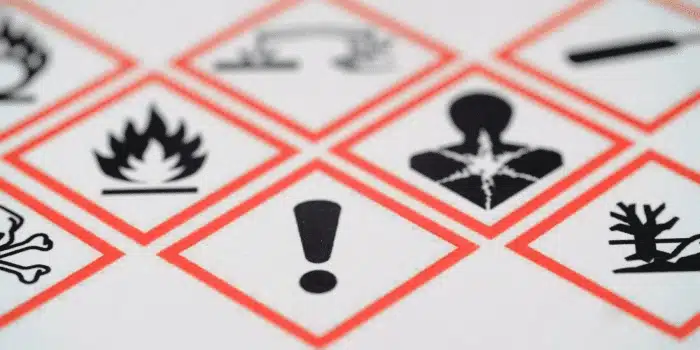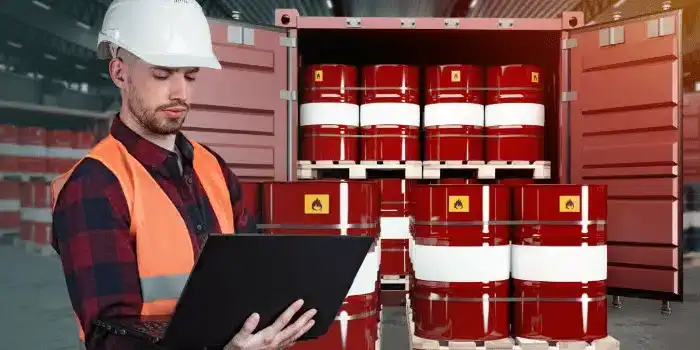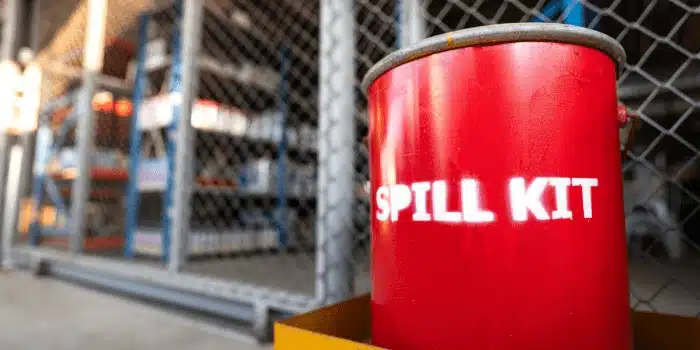
If you manage a warehouse or 3PL, then you know the importance of having an effective and safe storage process in place for all of your customers’ inventory and products used in the daily operation of your facility – especially dangerous goods. It’s vital to ensure that these hazardous materials (HAZMAT) are stored properly so they don’t present any safety risks to personnel or the environment as a whole.
Whether it’s ensuring your staff is correctly trained on hazmat warehouse storage and handling, knowing which labels have to be used and when, or understanding the regulations around temperature control – we’ve got you covered with tips and solutions to consider. Read on for more about what makes up a successful hazmat warehouse storage strategy for your 3PL or warehouse and best practices for meeting regulatory compliance standards.
What Products Are Considered Hazardous Materials

When most people think of dangerous goods, they often consider chemicals, flammable liquids, and explosives at the top of the list. While they are correct, the list of hazardous materials is much longer. As a standard rule, any products that fall under the following classifications are considered HAZMAT:
- Solids or Liquids that are Flammable
- Compressed Gases
- Explosives
- Radioactive Materials
- Liquid Corrosives, Oxidizers, or Organic Peroxide
- Biomedicals (equipment or items from the human or primate body)
- Cryogenics
- Poisons
If in doubt, always refer to the product’s label, material safety data sheet (MSDS), or manufacturer for details.
Ready to Elevate Your Operations? Contact us Today!
Seeking a comprehensive software solution that effortlessly integrates warehousing, transportation, accounting, and beyond?
Request a DemoWho Regulates Hazmat Storage and Handling?

Indoor and outdoor storage and handling of hazardous and dangerous materials are regulated by a variety of government agencies depending on the type of product and industry. It is their job to verify that companies are in compliance with crucial hazmat storage requirements set to protect the environment and ensure the safety of workers and those living near the warehouse or 3PL.
In most cases, the Department of Transportation (DOT), Environmental Protection Agency (EPA), Occupational Safety & Health Administration (OSHA), or local fire marshal will be responsible for enforcing regulations related to hazmat warehouse requirements for storage.
There are also several building and storage codes to follow for hazardous material storage. These regulations are set by the National Fire Protection Agency (NFPA), International Fire Code (IFC), International Building Code (IBC), Building Officials and Code Administrator (BOCA) Codes, and ATF as applicable. It’s important to research your local and federal laws to make sure your facility is in compliance as it relates to storing dangerous goods and hazardous waste and contact the agencies with any compliance questions.
Hazmat Warehouse Requirements for Storage

The exact EPA regulations or governing agency requirements for hazmat storage will vary depending on the type of product and warehouse location, but some common general rules include:
- Must be in an approved hazardous material storage area with an appropriate fire rating and climate control that is separated from other goods or materials. These can include storage lockers, cages, or other structures that comply.
- Safety signage should be erected in all company areas warning of hazardous material storage.
- Must be stored in containers that are compatible with the product and labeled according to EPA, OSHA, or other regulatory requirements. An ideal solution for the containment of chemicals includes using covered drum storage to prevent leaks or a spill.
- Must be kept away from sources of heat or ignition. A 3PL or warehouse should be equipped with a specific area of the facility far from these sources for hazardous material storage. It will help eliminate the risk of an explosion of chemicals or other combustible materials.
- Must not be exposed to direct sunlight, extreme temperature changes, moisture, or other conditions that could cause degradation or create a hazard. Warehouse management should work with their safety team to determine solutions for the best placement of climate-controlled storage lockers or areas within the facility to prevent conditions that would commonly occur otherwise.
- The temperature must also be monitored for hazardous material storage items that require specific temperatures like combustible liquids or solids, oxidizers, explosives, or flammable gases and liquids. These products or raw materials must also be stored away from each other to prevent the risk of a chain reaction ignition and a possible explosion. Refer to product MSDS sheets for details.
Specific rules may also apply depending on the type of product or material being stored. For example, certain hazardous materials require a fire suppression system in the storage area. They may include water, foam, or powder dispensing systems with the proper fire rating suppression capabilities.
Best Practices for Hazardous Material Storage

Regardless of the regulatory requirements, it’s important to develop best practices for hazardous material storage within your warehouse or 3PL facility or in your yard for safety. Some examples include:
- Developing a warehouse hazmat storage policy, which can be found in the employee handbook and must be adhered to at all times.
- Creating safety checklists that identify dangerous goods, hazmat storage locations, and any additional safety precautions.
- Strictly enforcing warehouse safety guidelines and policies in accordance with OSHA to ensure that all management and support staff members are aware of proper hazardous material handling procedures.
- Regularly inspecting all hazmat containers, as well as climate-controlled and drum storage units, to check for any signs of corrosion or leaks which could pose a risk to personnel or the environment.
- Monitoring your outdoor hazmat storage areas for flooding, foundation degradation, or wear and tear on tarps.
- Creating and maintaining emergency plans that identify all hazardous products stored in the facility and how to address any situation should a spill or leak occur. Be sure that your company’s plans include containment procedures, management contact information, and proper hazardous waste disposal. Make sure workers have easy access to safety equipment and items for cleanup.
- Implementing systems for climate control, temperature monitoring, proper air ventilation and exhausts, fire suppression systems, and other safety precautions as necessary.
- Supporting and managing continuing education training on hazmat safety procedures including proper labeling and handling of products according to MSDS sheets.
- Creating a detailed inventory system that keeps track of all items in hazmat warehouse storage, as well as dates of receipt and expiration. The ideal solution is to utilize your warehouse management system (WMS) software for inventory tracking and information on dangerous goods at your facility. Argos Software can work with your control framework to generate current and historical data reports.
By following these safety guidelines, you can ensure that you are properly storing hazardous products in your warehouse or 3PL facility and help protect both your staff and the environment.
Train Employees on Hazardous Material Safety

As mentioned above, it is important to have policies for hazmat storage and handling. It is also important to train your workforce on these safety procedures to prevent the risk of accidental contact, compromising spill, or EPA disaster. Make sure your workers are properly trained on the following topics:
- Identifying hazardous material symbols, labels, and product information listed on MSDS sheets.
- Handling and storage of hazardous products in accordance with fire rating, and federal, state, and local regulations.
- Proper use of PPE (personal protective equipment) such as respirators, gloves, face shields, safety goggles, suits resistant to chemicals, and other protective gear. Be sure that each staff member is equipped with the necessary PPE according to their job.
- Emergency procedures for responding to chemical spills or leaks, how to decontaminate, and dispose of hazardous waste properly.
- Educate your staff on the importance of following best practices for hazardous goods storage in order to ensure safe working conditions. This includes proper labeling and segregation of all hazardous material, proper storing techniques, and the maintenance of safety equipment.
To go one step further, warehouse management can send individuals for OSHA HASWOPER certification. HASWOPER stands for Hazardous Waste Operations and Emergency Response. The certification program is geared towards emergency response, containment, and cleanup situations and solutions, as well as for those that work in hazardous waste disposal. More information can be found on OSHA’s website.
By providing regular training sessions and refresher courses to your team, you can help reduce the risk of employee injury or environmental damage due to hazardous products in your warehouse or 3PL facility.
Hazardous Waste Disposal

The last step in managing dangerous goods is making sure that any waste produced by the storage and handling of these items is properly disposed of. Hazardous waste must be packaged, labeled, and managed according to federal, state, and local regulations. It is also important to ensure that all personnel are aware of the correct disposal process for any potentially dangerous material.
Make sure you have a plan in place for disposing of any hazardous material or solutions generated from your facility before it becomes an issue or poses a risk to workers or to nature. To make things easier, work with a third-party provider who specializes in hazardous waste collection, containment, and disposal solutions. They can help create an efficient waste management program that allows you to stay compliant with all applicable laws and regulations.
By following these guidelines, identifying problems and possible solutions, and implementing the right safety policies, you can ensure that your company is in compliance with all hazmat warehouse storage regulations. This will help keep your staff and community safe while still allowing you to store and ship your customer’s inventory. Taking these precautionary steps can not only help reduce incidents associated with storing dangerous goods but also helps protect your business from liability should an incident occur.




